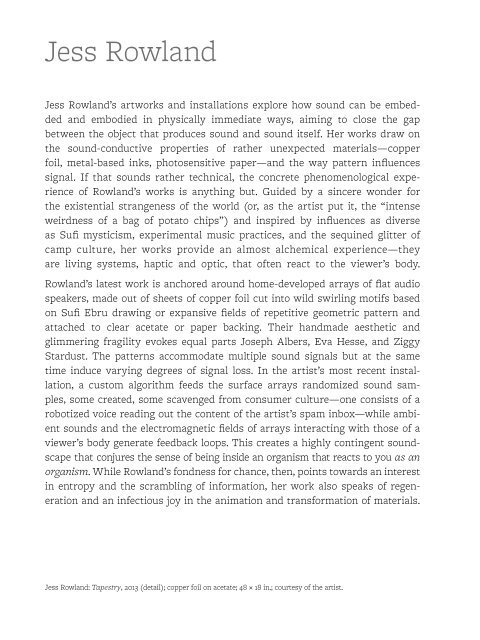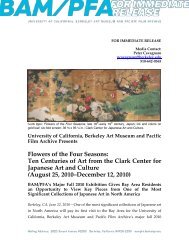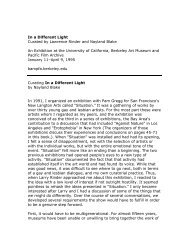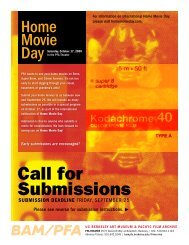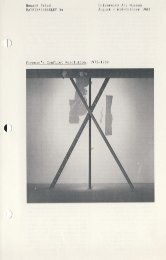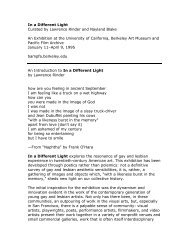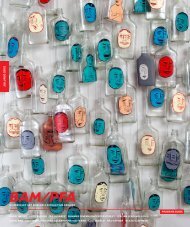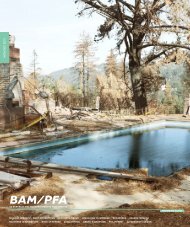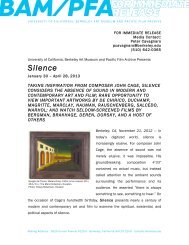exhibition brochure (PDF) - Berkeley Art Museum and Pacific Film ...
exhibition brochure (PDF) - Berkeley Art Museum and Pacific Film ...
exhibition brochure (PDF) - Berkeley Art Museum and Pacific Film ...
Create successful ePaper yourself
Turn your PDF publications into a flip-book with our unique Google optimized e-Paper software.
Jess Rowl<strong>and</strong><br />
Jess Rowl<strong>and</strong>’s artworks <strong>and</strong> installations explore how sound can be embedded<br />
<strong>and</strong> embodied in physically immediate ways, aiming to close the gap<br />
between the object that produces sound <strong>and</strong> sound itself. Her works draw on<br />
the sound-conductive properties of rather unexpected materials—copper<br />
foil, metal-based inks, photosensitive paper—<strong>and</strong> the way pattern influences<br />
signal. If that sounds rather technical, the concrete phenomenological experience<br />
of Rowl<strong>and</strong>’s works is anything but. Guided by a sincere wonder for<br />
the existential strangeness of the world (or, as the artist put it, the “intense<br />
weirdness of a bag of potato chips”) <strong>and</strong> inspired by influences as diverse<br />
as Sufi mysticism, experimental music practices, <strong>and</strong> the sequined glitter of<br />
camp culture, her works provide an almost alchemical experience—they<br />
are living systems, haptic <strong>and</strong> optic, that often react to the viewer’s body.<br />
Rowl<strong>and</strong>’s latest work is anchored around home-developed arrays of flat audio<br />
speakers, made out of sheets of copper foil cut into wild swirling motifs based<br />
on Sufi Ebru drawing or expansive fields of repetitive geometric pattern <strong>and</strong><br />
attached to clear acetate or paper backing. Their h<strong>and</strong>made aesthetic <strong>and</strong><br />
glimmering fragility evokes equal parts Joseph Albers, Eva Hesse, <strong>and</strong> Ziggy<br />
Stardust. The patterns accommodate multiple sound signals but at the same<br />
time induce varying degrees of signal loss. In the artist’s most recent installation,<br />
a custom algorithm feeds the surface arrays r<strong>and</strong>omized sound samples,<br />
some created, some scavenged from consumer culture—one consists of a<br />
robotized voice reading out the content of the artist’s spam inbox—while ambient<br />
sounds <strong>and</strong> the electromagnetic fields of arrays interacting with those of a<br />
viewer’s body generate feedback loops. This creates a highly contingent soundscape<br />
that conjures the sense of being inside an organism that reacts to you as an<br />
organism. While Rowl<strong>and</strong>’s fondness for chance, then, points towards an interest<br />
in entropy <strong>and</strong> the scrambling of information, her work also speaks of regeneration<br />
<strong>and</strong> an infectious joy in the animation <strong>and</strong> transformation of materials.<br />
Jess Rowl<strong>and</strong>: Tapestry, 2013 (detail); copper foil on acetate; 48 × 18 in.; courtesy of the artist.


